Browse Primary Sources
Locate primary sources, including images, objects, media, and texts. Annotations by scholars contextualize sources.
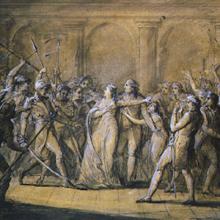
20 June 1791, Anonymous Drawing
In this depiction of the King’s arrest, the Queen risks her body to save her son, the crown prince.
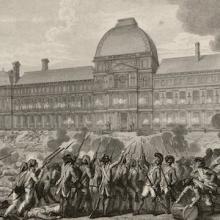
Day of 10 August 1792
This engraving gives a ground–eye view of the action; far from an orderly operation, the "day" appears chaotic and menacing, as the inspired people face what appear to be cannons being fired by royal soldiers. This romantic image would become the predominant view of this event.
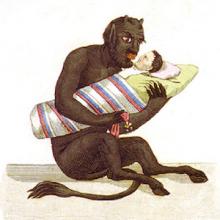
"This is My Dear Son": Napoleon as Child of the Devil
Linking Napoleon with Hell represents a far cry from his own propaganda. German propaganda piece depicting Napoleon as the child of the Devil.
This source is a part of the The Napoleonic Experience teaching module.
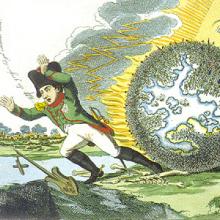
"The Song of the End": The Whole World Now Chases Him
Where Napoleon was once the conqueror, the world now avenges itself. This sense of reversal, felt widely outside of France, characterized a number of the caricatures of Napoleon, and indeed of the entire Revolution.
This source is a part of the The Napoleonic Experience teaching module.
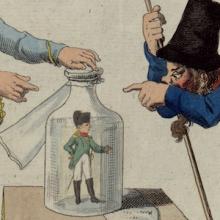
The Little Cartesian Devil
The reversal of circumstances that German cartoonists emphasized seemed generally to exercise considerable sway over this use of symbols. Here, Napoleon, who strode so large over Europe, is bottled and examined. Obsessed with his small stature, Napoleon might have been particularly displeased with this image.
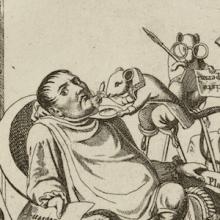
The Great Man
German cartoonists tried to reduce Napoleon down to size, in this case, the size of mice! Here the mice serve as courtiers.
This source is a part of the The Napoleonic Experience teaching module.
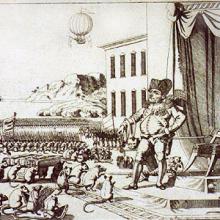
The Great Heroism of the Nineteenth Century
As in other caricatures, foreigners tried to humiliate Napoleon, once again using mice to represent those who would now attend him.
This source is a part of the The Napoleonic Experience teaching module.
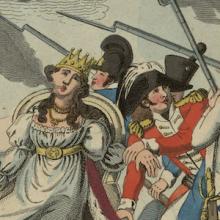
The Exorcism: Ridding France of the Devil Napoleon
The seal in the foreground, with its fleur–de–lys, indicates a return to royalism after France’s liberation from Napoleon. In addition, the secularism associated with the Revolution is countered with the image’s reference to the religious practice of exorcism.
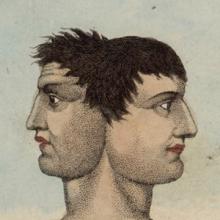
His Monument: Napoleon's Past and Future Are FIlled With Dead Bodies
This Janus–like figuration of Napoleon haunts the viewer as it suggests a future filled with skulls. Indeed, the unprecedented deaths from war and conquest of the last two centuries make this image seem predictive.
This source is a part of the The Napoleonic Experience teaching module.
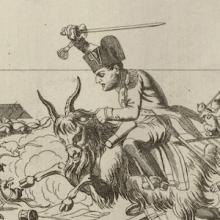
Celebrating Napoleon's Birthday on the Island of St. Helena
In this cartoon, Napoleon is portrayed as a buffoon, riding a goat in a charge against rodents, mocking his warlike instincts.
This source is a part of the The Napoleonic Experience teaching module.
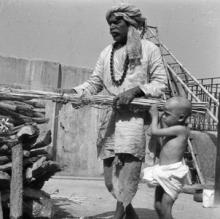
Cremation Rites with the Youngest Son, Calcutta 1944
The photographs depict a Hindu cremation site, or burning ghat, in the city of Calcutta in 1944. The first photo shows the men of the family, including the deceased's sons, seated in front of the corpse, which lies shrouded and bedecked with flowers on a bier. The child sitting on one of the men's laps at the head is the youngest son, a child of no more than 4-6 years old.
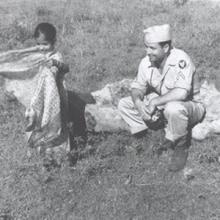
World War II American Soldiers and a Bengali Child
These photographs are among a series of fifteen taken in 1945 by U.S. soldier Glenn S. Hensley. Hensley was a professional photographer participating in aerial surveillance of Burma for the U.S. Army. The images illustrate an encounter between Hensley and four fellow U.S. airmen with the residents of the village of Kharagpur, West Bengal.
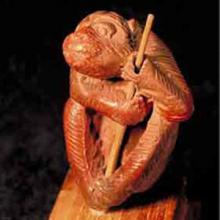
Indus Valley Climbing Monkey Toy
The monkey figurine shown in two views is mounted on a wooden platform for display, but it was apparently designed with the ability to slide down a string or thin rod so as to appear to climb or jump. The figurine is hand-modeled from terracotta and features a fully rounded body in a complicated, lifelike pose with a realistic facial expression, ears, and incised lines representing its fur.
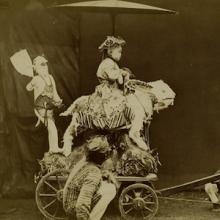
Chinese Children at the Tjap Go Meh Festival in Makassar
This photograph, dated 1880, shows Chinese children in a procession in the Tjap Go Meh Festival in Makassar, the largest city on the Indonesian island of Sulawesi. Tjap Go Meh is a Chinese festival that takes place 15 days after the Chinese New Year and marks the beginning of spring. It is also known as the Lantern Festival. People celebrate with parades and performances, such as acrobats.
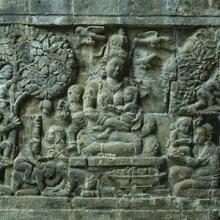
Hariti Relief Panel at Candi Mendut, Java
The carved stone relief is from the interior of Candi Mendut, a Buddhist temple in Central Java. Mendut was built during the early Shailendra dynasty in about 824 CE. It may have been built on the site of a Hindu temple from a previous century. The rectangular, stone temple is 26.4 meters (86.6 feet) tall and is constructed on a 2 meter (6.5 feet) platform.
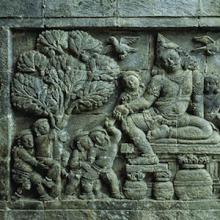
Kuwera Relief Panel at Candi Mendut, Java
The carved stone relief is from the interior of Candi Mendut, a Buddhist temple in Central Java. Mendut was built during the early Shailendra dynasty in about 824 CE. It may have been built on the site of a Hindu temple from a previous century. The rectangular, stone temple is 26.4 meters (86.6 feet) tall and is constructed on a 2 meter (6.5 feet) platform.
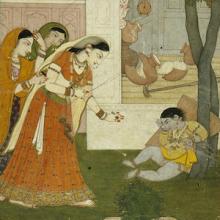
Krishna Tied to a Mortar for Stealing Butter
Krishna is known in the stories of the Bhagavata-Purana as the 8th incarnation of the god Vishnu, destined to perform great deeds and remove the evils of the world. Shown in this Indian miniature watercolor painting as a child with grey-blue skin, he is a popular deity, a divine hero who personifies superhuman powers as well as human hopes and failings.
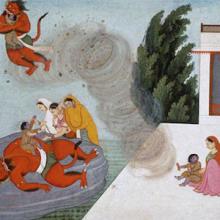
Krishna Defeats the Whirlwind
Krishna is known in the stories of the Bhagavata-Purana as the 8th incarnation of the god Vishnu, destined to perform great deeds and remove the evils of the world. Shown in this Indian miniature watercolor painting as a child with grey-blue skin, he is a popular deity, a divine hero who personifies superhuman powers as well as human hopes and failings.
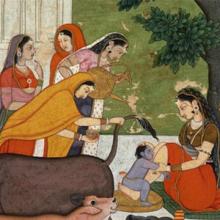
Krishna and the Cremation of Putana
Krishna is known in the stories of the Bhagavata-Purana as the 8th incarnation of the god Vishnu, destined to perform great deeds and remove the evils of the world. Shown in this Indian miniature watercolor painting as a child with grey-blue skin, he is a popular deity, a divine hero who personifies superhuman powers as well as human hopes and failings.
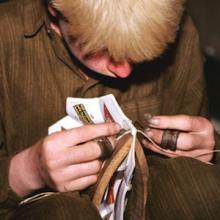
Soccer Ball Assembly Using Child Labor
This photograph of a boy stitching together the parts of a soccer ball was taken in Pakistan in 1998 to document the use of child labor in manufacturing soccer balls and other athletic equipment in South Asia. In the upper right hand corner of the photo, a young girl is also working.